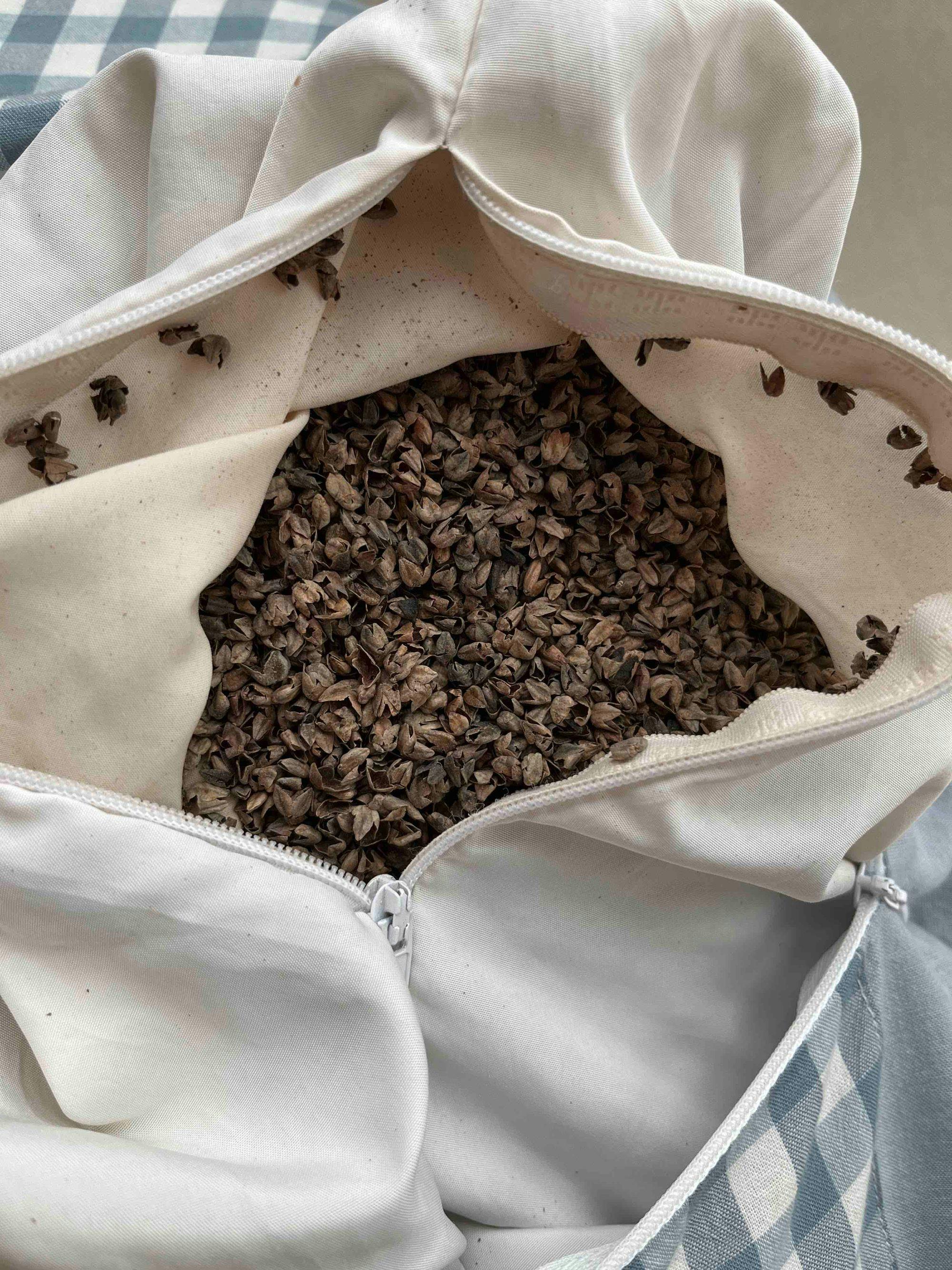Buckwheat hull pillows offer a unique solution for those seeking a more supportive and adjustable sleep experience. Their composition, from the hulls themselves to the materials of the pillowcase and cover, plays a crucial role in providing comfort and durability

To achieve the ideal firmness and height, it is essential to determine the right amount of buckwheat hulls to use.
Key Takeaways:
- With a proper calculation, you can get a precise starting point for the amount of hulls needed based on the size of your pillowcase.
- For a standard-sized pillow, start with 4 to 8 pounds of hulls, adjusting based on your preference.
- Buckwheat pillows are adjustable, so you can always add or remove hulls to suit your comfort over time.
Determining Pillow Size

Before choosing how much buckwheat hulls to refill the pillow, I start by considering the dimensions of the pillowcase. Typically, pillowcases come in standard sizes:
- Standard: 20 x 26 inches
- Queen: 20 x 30 inches
- King: 20 x 36 inches
I measure my pillowcase to confirm its size before I proceed.
Recommended Buckwheat Hull Amounts for Common Pillow Sizes
Filling a pillow with the correct amount of buckwheat hulls is essential to ensuring maximum comfort and support.
Here's a general rule of thumb on how much buckwheat hulls I suggest using for common pillow sizes:
- Standard Pillow (20" x 26"): I recommend between 4 to 8 pounds of buckwheat hulls for a firm and supportive pillow.
- Queen Pillow (20" x 30"): For this size, about 5 to 9 pounds is suitable, giving a good balance of flexibility and support.
- King Pillow (20" x 36"): This larger pillow works best with 6 to 10 pounds of hulls to maintain a consistent shape.
| Pillow Size | Approximate Weight of Buckwheat Hulls |
|---|---|
| Standard | 4-8 lbs |
| Queen | 5-9 lbs |
| King | 6-10 lbs |
Adjusting Fill for Comfort
The amount of buckwheat hulls can be adjusted based on personal preference for firmness. It's a bit of trial and error: you may start with the recommended amount and then add or remove hulls over time as I find my sweet spot.
Here's how I go about it.
For Firmer Support
If I prefer a firmer pillow, I'll tend to fill the higher end of the recommended amount of hulls.
For example, closer to 7 pounds for a standard pillow. This gives a solid, supportive structure that maintains its shape throughout the night.
For Softer Support
Conversely, if I like a softer feel, I'll start with lower end of the recommended hulls amount.
For example, around 4 pounds for a standard pillow and adjust from there. This allows the pillow to mold more readily to the shape of my head and neck.
Adjusting for Sleep Position
- Side Sleepers: Typically, I ensure my buckwheat pillow is more full to maintain proper spinal alignment.
- Back Sleepers: The fill varies; I adjust little by little to reach the perfect balance.
- Stomach Sleepers: I often remove more hulls, sometimes up to 2-5 pounds, to achieve a lower profile for better neck alignment.
Lastly, I pay attention to how my body reacts after sleeping on the adjusted pillow for a few nights and make further slight adjustments if necessary.
Remember that any changes to the volume of buckwheat hulls should be incremental to find the perfect balance for individual comfort.
Step-by-step Filling Procedure
Here's a step-by-step breakdown of my approach To fill a pillow with buckwheat hulls:
- Measure Your Pillow: I measure the dimensions of the pillow - width, length, and depth.
- Calculate Volume: Using the measurements, I calculate the volume of the buckwheat hulls to refill pillow.
Next, I follow these steps to fill the pillow:
- Prepare the Pillow Case: I ensure the pillow case is open and ready to be filled.
- Portion the Buckwheat Hulls: I measure out the buckwheat hulls according to the calculated volume.
- Fill the Pillow: Carefully, I pour the buckwheat hulls into the pillow case, avoiding spills.
- Adjust Fill: After initial filling, I add or remove hulls to achieve the desired firmness.
I recommend filling over a clean surface for easy cleanup of any spills. To ensure a consistent spread of the buckwheat hulls in the pillow, I fluff and distribute them evenly by hand.
Over time, the hulls may compress and additional hulls might be needed. For optimal maintenance, I sometimes remove and replace the hulls to maintain the pillow’s loft, as detailed on our Maintenance Guide for buckwheat pillows.
YZ Li
YZ, an engineer with a PhD based in the San Francisco Bay Area, brings practical expertise to Restful Guides. Focused on simple, effective ways to improve sleep and relaxation, YZ offers easy-to-follow advice on choosing the right pillows, bedding, and meditation techniques for a better, more restful life.
